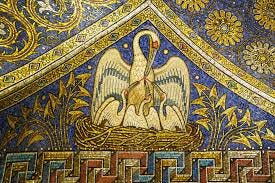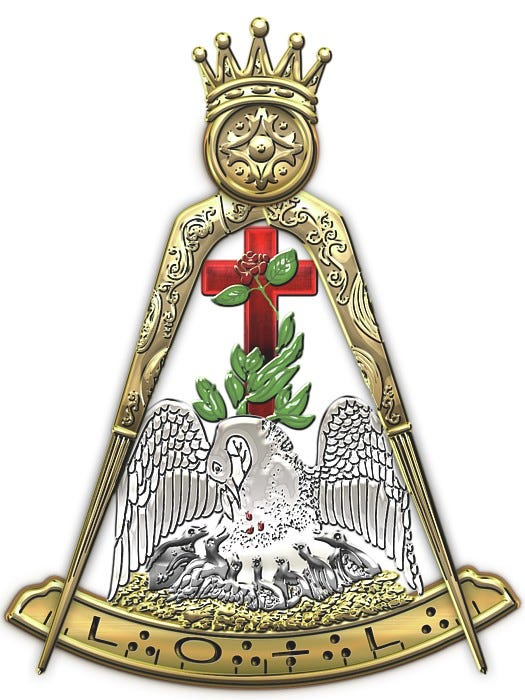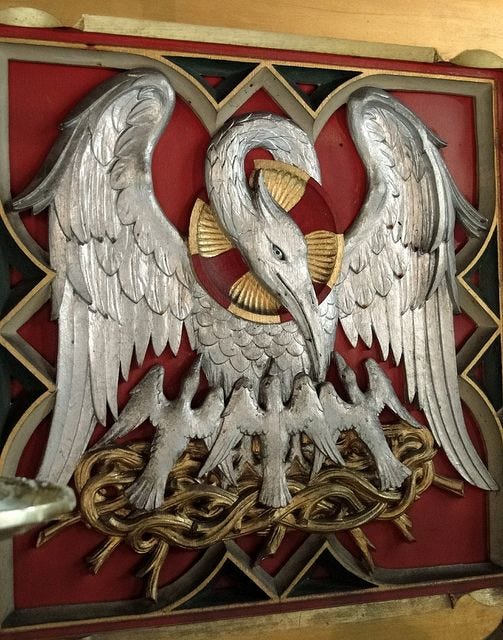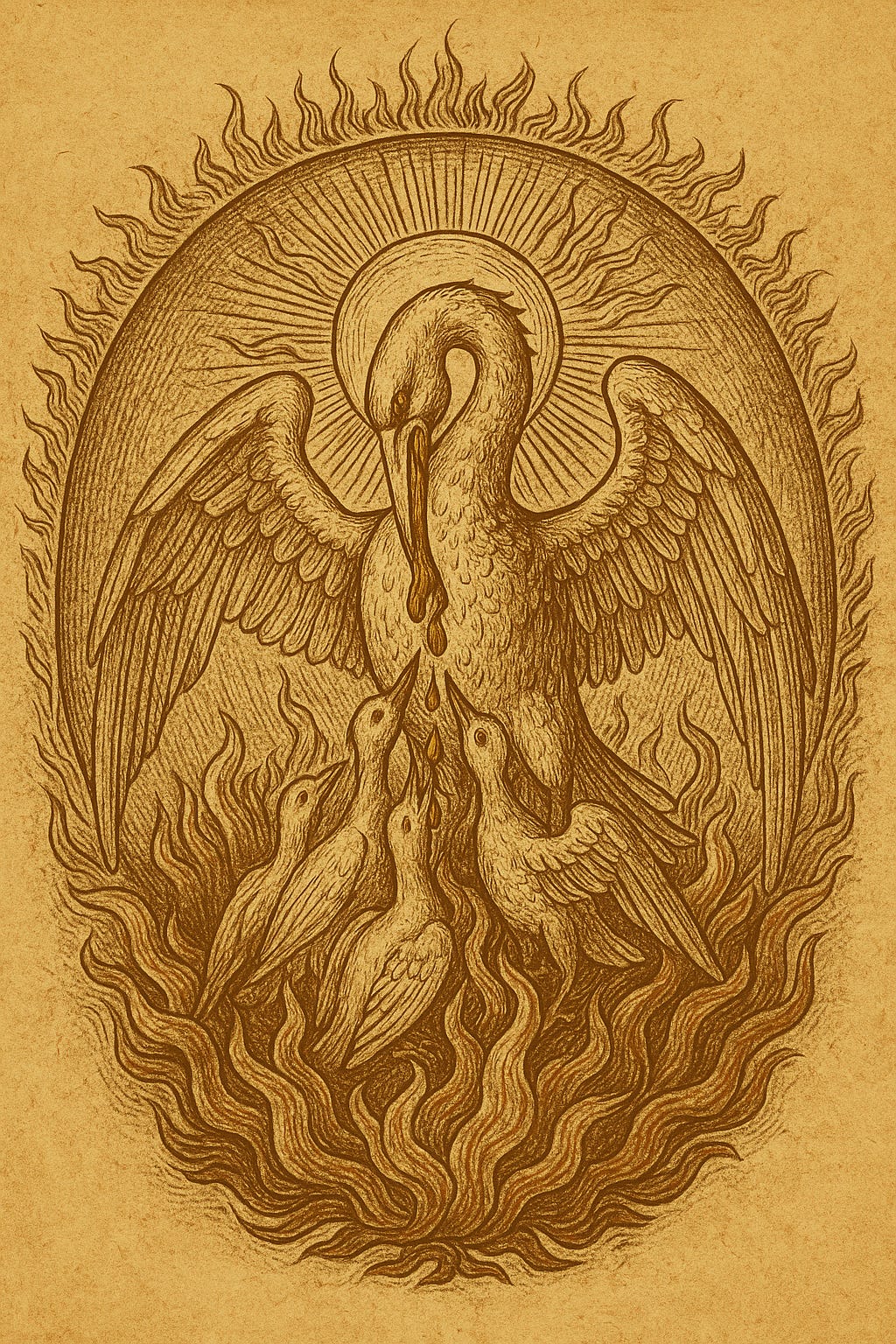The Pelican & the Alchemy of the Self
Sacrifice, Cognition, and the Transmutation of the Soul
Ex Corde Sacrificium
From the arcane depths of antiquity through the cloistered recesses of medieval cathedrals, from the gilded margins of illuminated manuscripts to the technical development of alchemical retorts, the figure of the pelican has quietly endured as one of the most powerful and overlooked symbols of inner transformation. Piercing its own breast to feed its young with blood, the pelican becomes more than a natural curiosity. It becomes a living glyph—an image of initiation, of self-sacrifice, of soul-metabolism in the higher work.
At once mystical and morphological, the pelican is also a phoenix of another kind: not one that burns in outer flame, but one that bleeds in inward fire. In the Goethean sense, it is a being whose gesture reveals the metamorphic nature of becoming—dying into being, sacrificing form for essence, feeding the future with the distilled tincture of the past. This is not metaphor. It is morphology infused with meaning.
Hieroglyph of the Inner Path
The pelican is not new to symbolism. In late antique bestiaries and the Christian Physiologus, it appears as a mother who revives her dead young after three days—piercing her own breast to breathe life into death. By the Middle Ages, this image became standard in Eucharistic iconography, and in alchemical and Rosicrucian traditions it found new vitality.
One of the most influential modern presentations of the pelican symbol came through Manly P. Hall, whose Secret Teachings of All Ages canonized the esoteric worldview for generations of seekers. Within it, Hall includes a an emblematic plate by J. Augustus Knapp, in which the pelican stands out as a central figure. In Knapp’s rendering, the bird feeds seven chicks—each corresponding to one of the classical planets, metals, or inner virtues. This is not sentiment—it is initiation. The pelican becomes an alchemical agent, a diagram of transformation, a mandala of the soul’s metamorphosis through sacrifice.
Knapp’s majestic rendering does not merely depict an allegory—it performs it. The stylized curves, the sacred geometry of the composition, the gaze of the mother pelican downward into her own wound—these are not decorative. They are gestural. And it is this gesture, above all, that Goethean science teaches us to observe.
Morphology of Gesture
In the Goethean mode of perception, the meaning of a living being is not abstracted from it, but encountered within it. We do not interpret Nature—we participate in it. We become inwardly mobile with the gesture of the form. The pelican, then, is not a symbol to decode but a gesture to inhabit—an alchemical arc of inward sacrifice: the beak, our awareness, curving toward the heart, the wings unfolding not in flight but in offering and embrace, the whole form revealing a metamorphic impulse, where selfhood dissolves into noble essence and becomes substance for the other.
This is not ornithology, but soul morphology.
The pelican’s form reveals a language of consciousness: a pattern of inward offering and outward sustenance. The image of beak to breast becomes an archetype—not of pain, but of generative sacrifice. It enacts the path of the initiate who, in the fire of spiritual striving, dissolves the hardened ego and distills from it an essence capable of nourishing the future.
Feeding the Organs of Higher Cognition
In esoteric thought, such as in the spiritual science of Rudolf Steiner, the human being is not complete, but becoming. Beyond the physical senses, new organs of cognition—imagination, inspiration, and intuition—await cultivation. These are not added mechanically by rote learning, but grown organically through moral striving, ethical refinement, and participatory cognition.
The pelican reveals how this nourishment takes place. It is not the delivery of ideas or dogmas, but the giving of essence—what has been inwardly digested and alchemically transformed. The teacher, the mystic, the artist—all who strive to midwife a new consciousness—must give from their own distilled being. This is the true tincture. The blood of the pelican is not blood—it is soul-substance, wrung from experience, made luminous by sacrifice.
This inward feeding is the hallmark of the veiled teacher, and the hidden school that nourishes through presence rather than proclamation.
Hidden Schools of Light
Throughout medieval and Renaissance Europe, amid cloistered abbeys and cathedral vaults, certain signs marked the presence of living esoteric work. Among these was the pelican. Carved into corbels, painted in chapel murals, or embroidered subtly in vestments, it served as an esoteric sigil for those who could read the language of the mysteries.
These were the scholae lucis—the schools of light—not formal seminaries, but spiritual sanctuaries. Within them, knowledge was not transmitted as theory but awakened as living cognition. The pelican did not mark doctrine—it marked deed. It meant: here, something has been transmuted; here, someone has given their essence so that others may be born anew.
The image of the Pelican in Her Piety appears in sacred contexts across Europe as a potent emblem of sacrificial love and spiritual nourishment. At Chartres Cathedral, the motif appears in a 13th-century stained glass window depicting the pelican feeding her young beneath a scene of King David, who holds a scroll inscribed with Similis factus sum pelicano—“I am like a pelican in the wilderness” (Psalm 102:6).
In St. Mary Redcliffe Church in Bristol, a stone carving of the pelican is placed beside the north porch entrance, embodying the Eucharistic principle of self-giving. The motif also appears in the armorial bearings of the Corpus Christi Colleges at both Oxford and Cambridge, where the pelican symbolizes the body of Christ and the nourishing power of divine sacrifice.
Beyond architecture, the image recurs in medieval illuminated manuscripts, altar frontals, and chalices, marking it as a deeply embedded initiatic symbol in Christian and esoteric iconography.
These visual texts are not decoration. They are encrypted diagrams of the alchemical path, designed not only to inform, but to initiate.
Alchemy, the Vessel, and the Pelican’s Inner Fire
In operative alchemy, the term “pelican” referred to a closed circulatory vessel used in cohobation—a process of distilling a substance in repeated cycles until its essence is purified. The inner dynamics of this glass pelican mimicked the act of self-offering. The substance returns to itself again and again, dissolving and recombining until it yields its tincture—the red elixir, the philosopher’s blood.
This process is mirrored in the alchemy of the soul. The heart becomes the vessel. Experience is distilled through suffering, recollection, and insight. Each cycle—of sorrow, of reflection, of renewal—brings us closer to the gold. The pelican does not merely give—it becomes itself through the act of giving.
This, too, is the phoenix work—not by flame, but by heart-fire. Not destruction, but metamorphosis.
Rosicrucian, Masonic, and Christic Currents
In Rosicrucian traditions and Scottish Rite Masonry, the pelican occupies a central symbolic place. It appears in the 18th Degree of the Knight Rose Croix, feeding seven young—aligned with the sevenfold schema of classical cosmology and internal virtue. Here, the initiate must not only understand the symbol but embody it. Each act of moral clarity, each trial endured and distilled into wisdom, becomes a drop of tincture poured back into the collective body.
Albert Pike, in his reflections on the Rose Croix, described the pelican as the icon of sacrificial love—not romantic charity, but the tempered fire of ethical becoming. To bleed as the pelican is to offer one’s essence—not for commendation, but because the work demands it.
Likewise, in esoteric Christianity, the pelican is not merely a symbol of Christ’s historical sacrifice, but a living icon of the Logos in continual self-offering—the divine principle that gives itself, again and again, through conscious love.
The pelican’s legendary act of reviving her young after three days parallels the Triduum, the three sacred days of the Christian mystery—Crucifixion (body), Entombment (soul), and Resurrection (spirit). This is not only a liturgical sequence, but a spiritual map: a process of absolute transmutation. Within this frame, the pelican’s blood is not the sign of death, but of distilled essence—the inner tincture extracted through sacrifice, nourishing the emergence of new life. It is the heart’s alchemy—where suffering becomes sustenance, and the path of descent becomes the gateway to resurrection.
Pelican as Phoenix
Unlike the solar blaze of the phoenix, the pelican belongs to the albedo, or whitening phase, of the alchemical Magnum Opus. This stage follows the nigredo (blackening), in which the ego is dissolved, and precedes the rubedo (reddening), the final integration of opposites. The pelican is a lunar being, associated with moonlight, inward tides, and the sacrificial outpouring of the purified heart. She offers not flame, but essence—feeding her young with her own blood in a gesture of selfless compassion. This blood is not consumed in fire, but transfigured through feeling—through the slow distillation of suffering into nourishment, of ego into luminous substance.
In this sense, the pelican is not separate from the phoenix, but prepares its coming. She is the archetype of purification, without which the fire of resurrection cannot ignite. When the alchemical process reaches its culmination in the rubedo, the purified soul blazes forth as the phoenix—the pelican transformed, no longer bleeding inwardly, but rising outwardly in radiant solar wholeness. The two are not opposites, but phases of the same metamorphosis: the pelican is the phoenix in gestation; the phoenix is the pelican fulfilled.
Goethe taught us to see form as revelation. The pelican reveals that dying is not the end, but the passage through which essence becomes radiant. This is the path of metamorphosis. It is not the return to the former self, but the emergence of the higher one.
To cognize the pelican is to embody the initiatic architecture of becoming—where sacrifice forms the scaffolding of transfiguration, where the self is unmade and remade through the quiet impulses of offering, and where each act of conscious giving lays a living stone in the temple of the soul’s ascent.
The Secret Gesture
The pelican does not exist to be worshipped. It exists to awaken. It calls us not to admire sacrifice, but to live it. Not to decode the image, but to become the gesture. It teaches us to feed the world not with repetition, but with radiant originality born of suffering transmuted into clarity.
To become the pelican is to feed the future. It is to pour forth what one has inwardly refined, to nourish the emergence of higher faculties in others, and in oneself. In the end, the pelican bleeds not for the past, but for what is yet to be born.
This is the mystery of transformation. And this is the secret the pelican maintains, silently, in stone and symbol, in chapel and vessel, in gesture and gaze.
Vita Mysterium. The Mystery is Life. The Pelican knows this—and lives it in every gesture.
Support Independent Research into Hidden Knowledge & Unexplored Dimensions
Thank you for reading. If this work has resonated with you, stirred your thinking, or opened new perspectives, know that your engagement is not passive—it is participatory. This research explores the neglected frontiers of consciousness, cosmology, and sacred history, illuminating the structures of reality often dismissed by institutional narratives.
🎯 Make a Direct Impact
🔸 PayPal: paypal.me/alkemix33
🔸 Explore the Course — Archetypal Vision: alkemix.gumroad.com
🔸 Wear Sacred Threads: etsy.com/shop/AlkemixArts
Why It Matters
Each contribution directly supports:
Deep-dive investigation into suppressed and forgotten knowledge
Explorations of alternative scientific, metaphysical, and historical paradigms
The creation of original, symbolically informed content that challenges surface-level narratives
The preservation and renewal of initiatic traditions in a post-dogmatic world
Whether you share, support, or engage in meaningful dialogue, you’re participating in the reawakening of a deeper mode of knowing—one that sees through the surfaces and listens to the living heart of things.
“Give, and you are instantly richer—what you offer becomes your power.” — Plotinus
What people say about my work:
“Thomas’ lectures are worth watching several times. Gold in every minute. So grateful for them.” —JE
“The absolute best. It always fills me with joy to watch Thomas’ lectures, restores my sanity in these crazy times.” —KS
“I so love your work. You’re a beautiful human angel.” —JG
“Your work is very important, continues to be a solid support and inspiration to me through all the madness, Thomas - thank you!” —K
“Thomas has labored long and mightily in that most difficult of all assignments: presentation of new ideas and conceptions to a world determined to go to hell.” —Trevor James Constable
























Very interesting, and Ive been listening to Steiner lectures, like Nature and Spirit Beings, and he always talks about man's transformation. Question though, I searched for actual footage or photo of a pelican feeding it's blood but couldn't find any. Then AI says it could be a misinterpretation of them feeding regurgitated fish.
The phrase, "moral striving" Tom quotes when paraphrasing Steiner's idea that we are developing three qualities of soul (imagination inspiration intuition) isn't the best translation for the concept. I think it's better to understand it as 'the self-evident knowledge gained from inspirations'.
Fascinating article, whether or not it is naturalistically accurate.